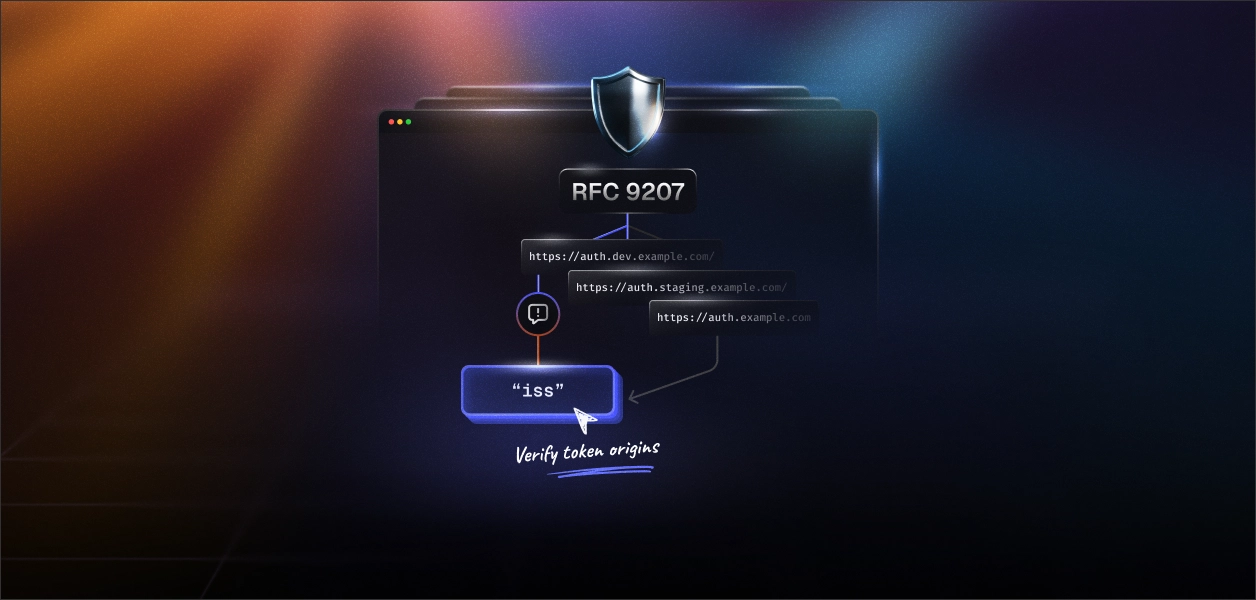OAuth 2.0 authorization server issuer identification: RFC 9207 explained

When your B2B app integrates with multiple partner APIs, your app receives OAuth tokens after users authenticate with partner authorization servers. But how can your app reliably confirm which authorization server actually issued a given token?
OAuth 2.0 is widely used for securing APIs and managing access control. However, a known vulnerability called the "mix-up attack" threatens applications that use multiple authorization servers. RFC 9207 addresses this by explicitly identifying the authorization server that issued tokens, thereby providing multi-environment support.
Understanding the issuer identification problem
OAuth clients commonly interact with multiple authorization servers across different environments such as development, staging, and production. However, standard OAuth responses don't include explicit issuer identifiers, making it challenging for clients to verify who issued the response. This ambiguity can lead to mix-up attacks, where attackers trick clients into sending credentials to the wrong authorization server.
RFC 9207 solves this by introducing an iss (issuer) parameter in OAuth authorization responses. This parameter explicitly identifies the authorization server, allowing clients to verify responses accurately.
What is a mix-up attack?
A mix-up attack occurs when an attacker tricks your OAuth client into sending sensitive information (like authorization codes) to the attacker's authorization server instead of the legitimate one. This typically happens when your app integrates multiple authorization servers, and the client gets confused about the issuer's identity.
RFC 9207 effectively mitigates these attacks by providing explicit issuer identification.
Practical applications of RFC 9207
Here’s why issuer identification is valuable:
1. Multi-environment deployments (Dev, Staging, Prod)
When your application connects to different authorization servers for each environment, the iss parameter helps confirm you're receiving tokens from the correct environment.
Example:
Let’s look at how the iss parameter will look like for different environments.
- Dev: https://auth.dev.example.com
- Staging: https://auth.staging.example.com
- Prod: https://auth.example.com
2. Preventing mix-up attacks
Applications using multiple external identity providers (Google, Facebook, Okta, custom OAuth servers) must ensure they send authorization codes only to the intended authorization server.
3. Debugging and traceability
Explicit issuer identification simplifies debugging by clearly showing which server issued each OAuth response.
How RFC 9207 issuer identification works (Step-by-step example)
Imagine you're building a photo-sharing app (photoshare) that authenticates via multiple OAuth providers, including your own production and staging environments.
Step 1: Authorization request (Client to auth server)
Your client initiates an OAuth request to the authorization server:
Step 2: Authorization response with iss parameter
The authorization server responds, explicitly including the issuer identifier (iss):
Step 3: Client validation of iss
Your client application MUST verify that the returned iss matches the expected issuer. If the issuer mismatches, the client rejects the authorization response.
Example error response (with iss):
Even in error cases, the client verifies the iss value to ensure authenticity.
How authorization servers advertise support for iss
Authorization servers explicitly declare support for the iss parameter in their metadata:
Clients can rely on this metadata to expect and enforce issuer validation.
Security considerations and best practices
- Strict issuer validation: Clients must strictly validate issuer identifiers to prevent token confusion and potential attacks.
- Unique issuer per server: Every authorization server in your environment must have a unique issuer identifier (URL).
- HTTPS enforcement: The iss value must always use HTTPS URLs to avoid tampering and spoofing.
- Fallback considerations: Decide carefully if your client should accept authorization responses without the iss parameter based on your security policies.
For a deep-dive into the best practices specification, head to this blog.
How does RFC 9207 help AI agents?
AI agents acting as OAuth clients often interact with multiple authorization servers, especially in multi-service or multi-environment scenarios. RFC 9207 helps agents:
- Explicitly verify tokens originated from the intended authorization server.
- Prevent token mix-up scenarios when integrating multiple external services.
- Debug OAuth issues by clearly identifying the issuer of each response.
However, for high-frequency agent-to-agent communications where performance is critical, ensure you weigh the overhead of explicit validation against the benefits.
Common developer mistakes (and how to avoid them)
Mistake: Ignoring issuer validation entirely.
Correct: Always validate the iss parameter explicitly:
Mistake: Sharing the same issuer URL between different environments.
Correct: Assign distinct issuer identifiers to each authorization server environment.
Edge cases to consider
- Ensure metadata from authorization servers accurately declares support for iss.
- Clearly handle scenarios where issuer values mismatch (logging and alerting).
Conclusion: Clarity and security for multi-environment OAuth
RFC 9207 provides explicit issuer identification, protecting OAuth 2.0 clients from mix-up attacks and confusion across multiple environments. By clearly defining and verifying issuer identifiers, your OAuth integrations become safer, easier to debug, and more robust—especially important when integrating multiple OAuth providers or supporting development, staging, and production environments.
Implementing RFC 9207 helps your applications and your AI agents answer a crucial question clearly: "Can I trust that this OAuth response is from the right authorization server?"













